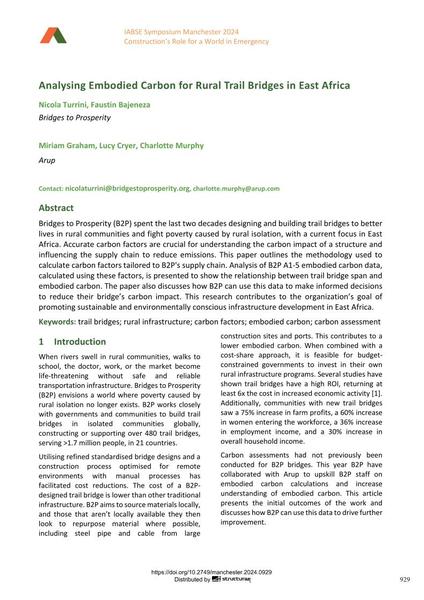Analysing Embodied Carbon for Rural Trail Bridges in East Africa

|
|
|||||||||||
Bibliographic Details
| Author(s): |
Nicola Turrini
(Bridges to Prosperity)
Faustin Bajeneza (Bridges to Prosperity) Miriam Graham (Arup) Lucy Cryer (Arup) Charlotte Murphy (Arup) |
||||
|---|---|---|---|---|---|
| Medium: | conference paper | ||||
| Language(s): | English | ||||
| Conference: | IABSE Symposium: Construction’s Role for a World in Emergency, Manchester, United Kingdom, 10-14 April 2024 | ||||
| Published in: | IABSE Symposium Manchester 2024 | ||||
|
|||||
| Page(s): | 929-937 | ||||
| Total no. of pages: | 9 | ||||
| DOI: | 10.2749/manchester.2024.0929 | ||||
| Abstract: |
Bridges to Prosperity (B2P) spent the last two decades designing and building trail bridges to better lives in rural communities and fight poverty caused by rural isolation, with a current focus in East Africa. Accurate carbon factors are crucial for understanding the carbon impact of a structure and influencing the supply chain to reduce emissions. This paper outlines the methodology used to calculate carbon factors tailored to B2P's supply chain. Analysis of B2P A1-5 embodied carbon data, calculated using these factors, is presented to show the relationship between trail bridge span and embodied carbon. The paper also discusses how B2P can use this data to make informed decisions to reduce their bridge’s carbon impact. This research contributes to the organization’s goal of promoting sustainable and environmentally conscious infrastructure development in East Africa. |
||||
| Keywords: |
trail bridges embodied carbon carbon assessment rural infrastructure carbon factors
|
||||
